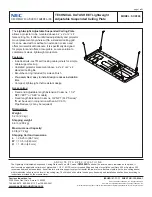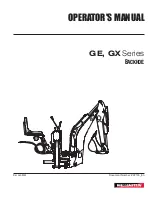
28
Lubrication
The fan shaft bearings, the supply fan motors, the
condenser fan motors and compressors are permanently
lubricated.
Inspection & Cleaning
All flue product carrying areas of the furnace, its vent
system, and main burners should be examined by a
qualified service agency, and cleaned if necessary, before
the start of each heating season. This examination is
necessary for continued safe operation. Particular attention
should be given to deterioration from corrosion or other
sources. This examination is accomplished in the following
manner.
1. Disconnect power to the unit and remove furnace
section access panel.
2. Remove burner assembly:
a. Disconnect the wires from the gas valve after
noting which wires are connected to each
terminal.
b.
Disconnect wires from the flame rod and ignition
electrode.
c. Disconnect the gas piping at the union.
d. The entire burner assembly can now be
removed from the unit.
NOTE: Use all screws that were removed; they are
necessary for safe and proper operation of the
unit.
3. Inspect and periodically clean the vent outlet (bird
screen) on the access panel.
NOTE: Periodic observation of the flame and a
log of C0
2
measurements are recommended. This
will aid in determining whether the furnace is
operating efficiently or if the furnace requires
cleaning.
Flames should be stable, soft and blue (dust may cause
orange tips but must not be yellow). The flames must
extend directly outward from the burner without curling,
floating or lifting off.
Check the burner flames for:
1. Good adjustment
2. Stable, soft and blue
3. Not curling, floating, or lifting off.
burner flame
Figure 15
WARNING
To avoid personal injury or death due to electric
shock, do not remove any internal compartment
covers or attempt any adjustment. Contact a
qualified servicer at once if an abnormal flame
should develop.
At least once a year, prior to or during the heating season,
make a visual check of the burner flames.
NOTE: This will involve removing and reinstalling
the heat exchanger door on the unit, which is held
by two screws. If you are uncertain about your
ability to do this, contact a qualified servicer.
If a strong wind is blowing, it may alter the airflow pattern
within the unit enough that an inspection of the burner
flames is not possible.
Functional Parts
Refer to the unit Parts Catalog for a list of functional parts.
Parts are available from your distributor.
TROUBLESHOOTING
Ignition Control Error Codes
The following presents probable causes of questionable
unit operation. Refer to
Diagnostic Indicator Chart
for
an interpretation of the signal and to this section for an
explanation.
Remove the control box access panel and note the number
of diagnostic LED flashes.
Internal Control Failure
If the integrated ignition control in this unit encounters an
internal fault, it will go into a “hard” lockout and turn off the
diagnostic LED. If diagnostic LED indicates an internal
fault, check power supply to unit for proper voltage, check
all fuses, circuit breakers and wiring. Disconnect electric
power for five seconds. If LED remains off after restoring
power, replace control.
Abnormal Operation - Heating Codes
External Lockout (1 FLASH CODE)
An external lockout occurs if the integrated ignition control
determines that a measurable combustion cannot be
established within three (3) consecutive ignition attempts.
If flame is not established within the seven (7) second trial
for ignition, the gas valve is deenergized, 15 second inter-
purge cycle is completed, and ignition is reattempted. The
control will repeat this routine three times if a measurable
combustion is not established. The control will then shut
off the induced draft blower and go into a lockout state.
















































